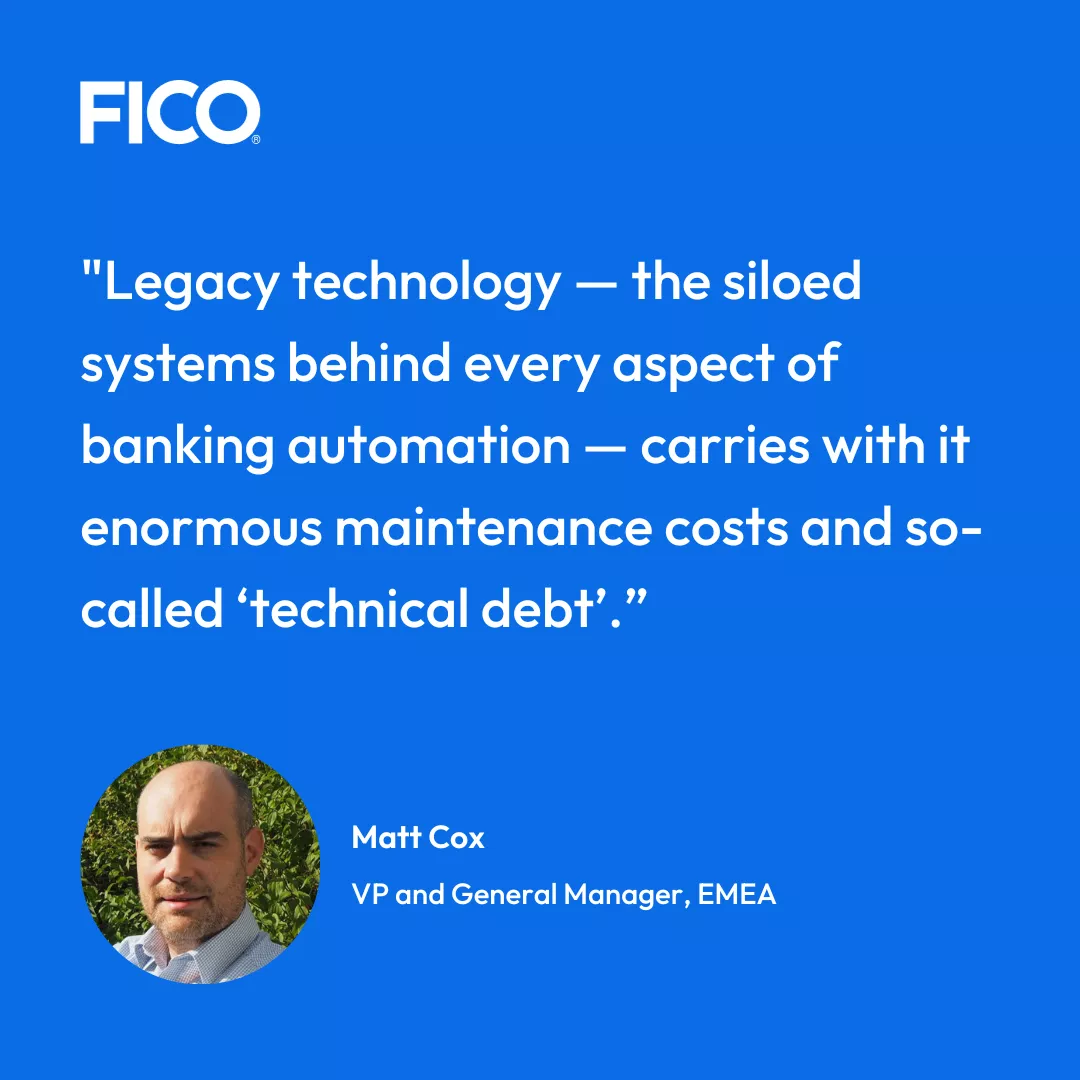Enterprise Decisioning: The IT Trend That’s Transforming Banking
The drive to reduce technical debt from disconnected legacy systems is leading banks to enterprise decision platforms - with benefits for IT, the commercial team and consumers

In an interview this month with Retail Banker International’s Douglas Blakey, I was asked what I saw as the top trend for banks in EMEA, and what I forecast as the trend for 2024. Both answers are the same: the move to an enterprise approach to software and technology, to replace the siloed legacy systems used today.
This may not sound surprising, given that the banking industry has talked about this for years. But it’s finally happening and is rapidly accelerating. And while its proponents have often been on the risk management, marketing and product management side of the house, the momentum now is being driven by forward-looking CIOs and CTOs. They have taken the lead because the advantages of an enterprise approach are so compelling — and the status quo is unsustainable.

Legacy Technology Is Choking IT and Strangling Growth
Legacy technology — the siloed systems behind every aspect of banking automation — carries with it enormous maintenance costs and so-called “technical debt.” I have spoken to banks with 15 systems for managing customers, each with its own data repository. This makes it nearly impossible to take true customer-focused decisions, because each system is constructing its own profile of the customer based on its own data.
These systems are a real burden on growth and profitability. Business owners will complain about the months it takes to spin up a new project or customer offer. This can take up to a year for some organizations, putting them in a distinctly uncompetitive position while they wait for IT. But from an IT perspective, the resources to serve every area of the business, to manage every system, to execute every change to strategy, simply aren’t there.
This is especially true given that a greater proportion of IT budgets are being spent simply on meeting new regulatory obligations. In the UK, Consumer Duty is a very recent example of this – in an Ernst & Young survey, more than 85% of firms identified technology transformation as playing a role in meeting the requirements.
Moving to an Enterprise Platform Approach
This is why IT is championing a move to enterprise-wide decision platforms built on microservices and common capabilities that can be configured to rapidly meet new business needs. One of FICO’s customers, Bradesco, has leveraged the same set of microservices in FICO Platform to power more than 150 initiatives across the bank.
These systems also enable business owners to make changes to decision strategies without getting into an IT queue — a win for both sides of the equation. This also greatly reduces the time to make such changes, improving agility and competitiveness. A good example is Bank of Montreal, which has reported being able to deploy decision changes twice as fast as before.
Another advantage for IT is that they can distribute the costs of systems more effectively. In a transaction-based SaaS model, charges can be applied to the activity by the commercial team that generates revenue. This reduces the fixed costs of the business by switching fixed costs to variable costs, CapEx to RevEx, freeing up the CapEx budget for other priorities.
Benefits for All Parties
The impact of this enterprise transformation will be big not just for banks but for their customers:
IT teams becoming revenue makers and innovators vs cost centers, having more of a commercial impact. At an event last year, Gavin Reuben, Chief Information Officer, BluNova, said that by moving their use of FICO Platform from on-prem to cloud, he was able to stop focusing on software maintenance and focus instead on innovation and business transformation.
Moving to a shared set of tools and capabilities can bring significant savings in IT by moving away from various bespoke solutions requiring different training, maintenance, etc.
Business teams have more control over their decision strategies, which improves performance.
Customers will finally feel like the bank really knows them. By breaking down the compartmentalization we see today, banks can have the insight to make more consumer-specific decisions. The risk of not doing this is significant: a recent Gartner survey showed that brands risk losing more than 1 in 3 of their customers due to poor personalization.
Enterprise Transformation in 2024
Where will this go in 2024? I see it continuing apace, with laggards looking to jump on the trend as their competitors see the benefits spreading.
Banks that have started their platform journey for enterprise decisioning will rapidly spread the benefits from originations to marketing, customer management and collections. This will lead to better decisions at a lower cost. These organizations will be able to understand their customers’ needs, characteristics and priorities in much more depth, which creates greater clarity about what products to offer, and which communications and service processes will provide the best customer outcomes.
In the UK, this will provide clear advantages when it comes to meeting the Consumer Duty requirements. Achieving excellence in the Consumer Duty arena is expected to become a competitive differentiator.
While there are leaders and laggards within individual markets, there are also countries that are behind in taking this enterprise platform approach. We work with banks worldwide, and there is rapid adoption in the UK, the US, Canada and much of Latin America. Within EMEA, we have seen the greatest progress in the UK, in Turkey, in South Africa and in the Nordics. Banks in western Europe appear to be slower in taking up this approach, and 2024 will be critical for the early adopters.
The other change I see in 2024 is the expansion of this approach into fraud management. To date, banks’ fraud teams have lagged the commercial and risk teams in this approach; they are still more reliant on point solutions, and have a high technical debt. I expect to see more movement in the next couple of years toward a more holistic approach that is better integrated with the rest of the business.
For example, we are now having more discussions with banks where application fraud is being discussed as part of the origination credit risk journey. Previously, originations and application fraud were managed by two teams with different systems; a platform approach could ensure more consistent decisions and better fraud identification to boot.
How an Enterprise Platform Approach Advances Your Digital Transformation
Read an article from The Journal of Digital Banking, “How Financial Services Leaders Are Using Enterprise Intelligence to Optimize Efficiency Ratios
Explore innovation with FICO Platform
Watch FICO Platform in action with the story of your everyday consumer, Digital Jane.
Popular Posts

Business and IT Alignment is Critical to Your AI Success
These are the five pillars that can unite business and IT goals and convert artificial intelligence into measurable value — fast
Read more
FICO® Score 10T Decisively Beats VantageScore 4.0 on Predictability
An analysis by FICO data scientists has found that FICO Score 10T significantly outperforms VantageScore 4.0 in mortgage origination predictive power.
Read more
Average U.S. FICO Score at 717 as More Consumers Face Financial Headwinds
Outlier or Start of a New Credit Score Trend?
Read moreTake the next step
Connect with FICO for answers to all your product and solution questions. Interested in becoming a business partner? Contact us to learn more. We look forward to hearing from you.
